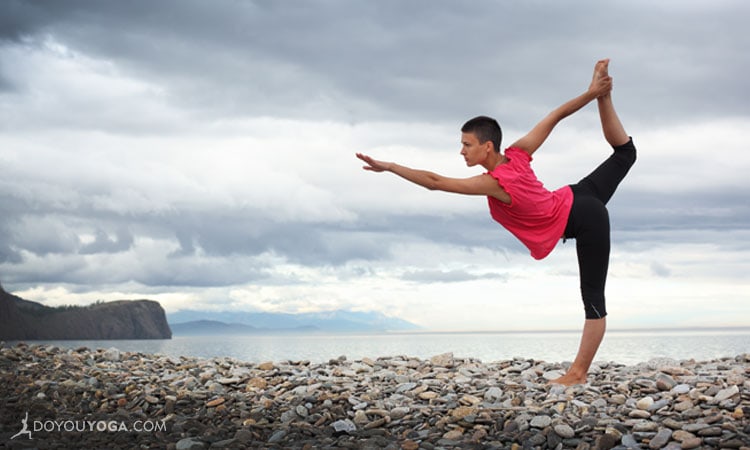Flexibility often feels like the Holy Grail of yoga, doesn't it? The steady stream of awe-inspiring, super bendy yoga selfies has motivated more than a few of us to hit our mats in an effort to touch our toes (at least) and mimic our yoga teachers and heroes at best.
But what we may have forgotten in our zeal to get our palms on the floor is that flexibility goes deeper than loose hamstrings — it's an essential part of thriving in all areas of living.
Being flexible (in body and mind), is a mark of resilience. Flexibility gives us access to expand and deepen our practice of yoga, and life. So why does it seem so unattainable?
Flexibility Is A Journey
I'm gonna let you in on a little secret: the yoga world is chock-full of practitioners (ex-dancers and gymnasts, among them) who make “impossible” poses look effortless! The vast majority of these beautiful and inspiring folks have put in yearsss of practice, on and off the mat, to get to where they are now.
They will also be the first to point out that flexibility is a journey, rather than a destination. The key is understanding what flexibility means for you and where it comes from.
Build A Flexible Foundation
According to Ayurveda, improved flexibility comes from creating a delicate balance between the doshas by reducing the cold, dry qualities of vata (which create stiffness, and tightness in the muscles), moderating the heat of pitta (which can cause inflammation), and balancing the heavy, oiliness of kapha (which lubricates the the joints).
Striking this balance means addressing the needs of the mind, body and spirit, and would include some (or all) of the following:
1. Eat fresh… but don't over do it.
Fresh, organic and seasonal food is the best! Steer clear of anything processed and make sure to get plenty of greens, fruits and healthy fats. Stay hydrated and avoid overeating so as not to overload your digestion.
Particularly good foods to add to your diet are: Fatty fish (salmon, mackerel), almonds, walnuts, garlic and onions, dark greens like spinach, kale, sea veggies and wheat grass.
2. Add herbs and spices to the mix.
Everyday spices like cinnamon, ginger and turmeric are the flexibility “go-to” spices as they promote circulation and stimulate the movement of energy in the body, while decreasing inflammation and stagnation. Ayurvedic herbs like guggul and dashmula are also good for increased flexibility.
3. Lubricate
Well known Ayurvedic vaidya Vasant Lad says “a dry body, like a dry stick, breaks easily.” Applying oil allows the body to become more flexible, and able to bend with the challenges of life. Regular self massage or “Abhyanga” sends a message of love and worthiness to the body and creates a more grounded and supple you.
3 Elements To Being Flexible
Wanna be bendy? Being adaptable is key. My approach to being mentally, and emotionally adaptable includes the following three elements:
1. Practice Awareness
Tune in to your potential for flexibility by increasing your awareness of the give and take of daily living. We live in a constant state of give and take with our bodies, our environment and our own minds. Approaching it as a dance, rather than a tug of war, opens your mind and body to what you're capable of—rather than what you're up against.
2. Choose Happy
Yep, it's a choice. And it's offered up numerous times every day. When you sleep through your alarm, or miss the train, when you're spouse or partner picks a fight, or you lose your phone for the fifth time.
Choosing happy in these times calms the mind and body, delays the “fight or flight” response, and, believe it or not, contributes to your mental, and physical flexibility.
3. Create Space To Move
Keep your physical and mental space clear of clutter and “noise.” Get rid of things you don't need, let go of beliefs that don't serve you. Forgive.
When scheduling your day, include space around your activities to give you time to get things done in a way that doesn't feel rushed or stressful and also gives you the ability to adapt to changes as they arise without stress.
Don't Forget To Breathe
A key aspect of flexibility is the ability to effectively relax the muscles (and the mindset) in order to allow expansion. Focused breathing relaxes the mind and the body, while nourishing and smoothing muscle contraction for greater mobility and control.
Yogic breathing exercises like Alternate nostril breath or 3-Part breathing are simple exercises that pack a powerful punch. Try a few rounds of focused breathing every day in the morning and evening.
“The Goal of Yoga is adaptability, not flexibility.” – Judith Hanson Lasater
If flexibility is what you're after, consider expanding your scope beyond just stretching and embrace the part that your mind and spirit have to play in creating a bendier you.
And the next time you step on your mat, remember that being flexible is about more than touching your toes, it starts with who you are being.


